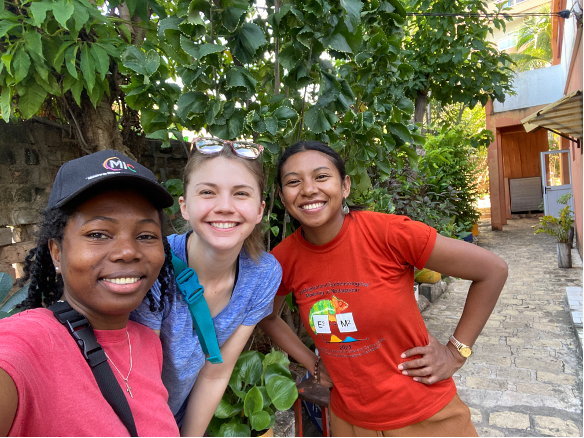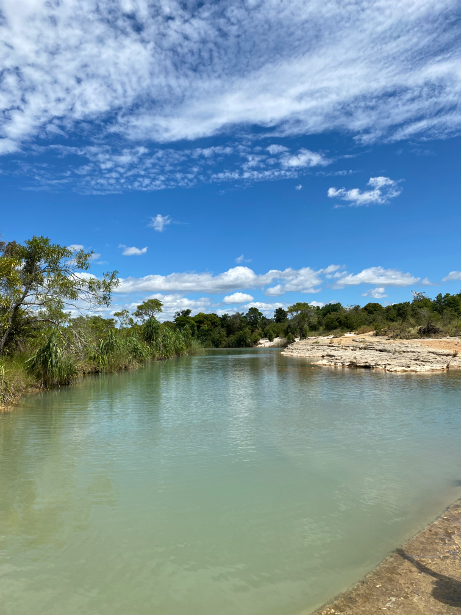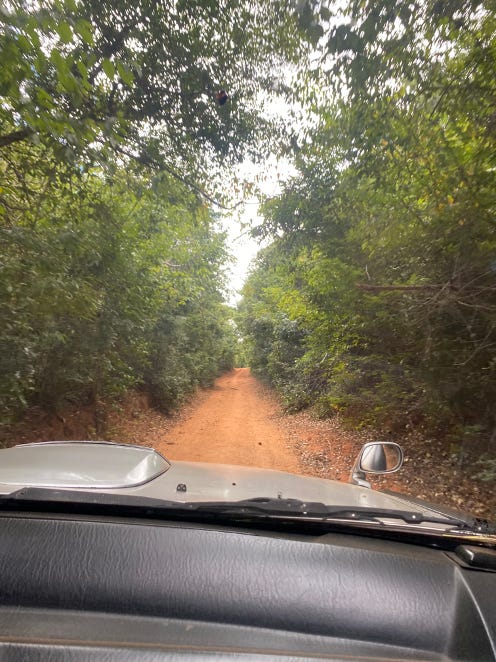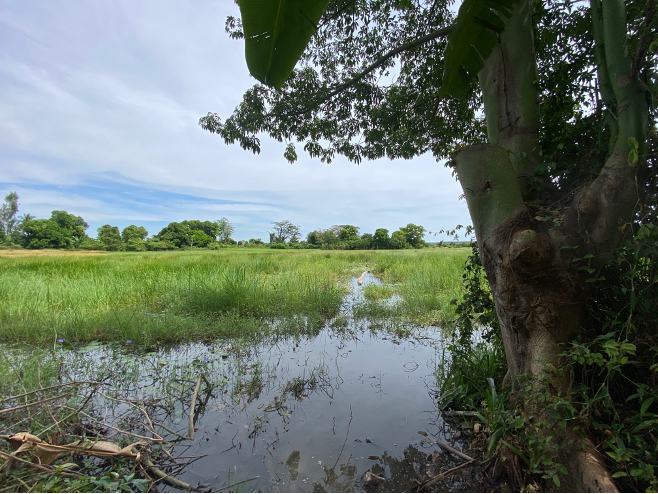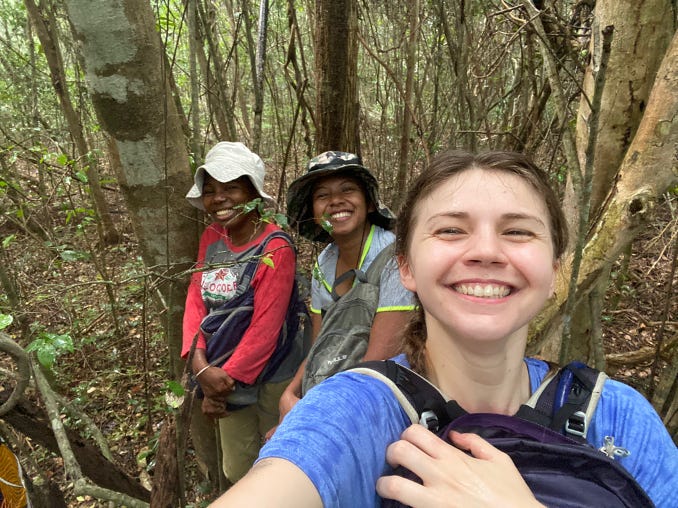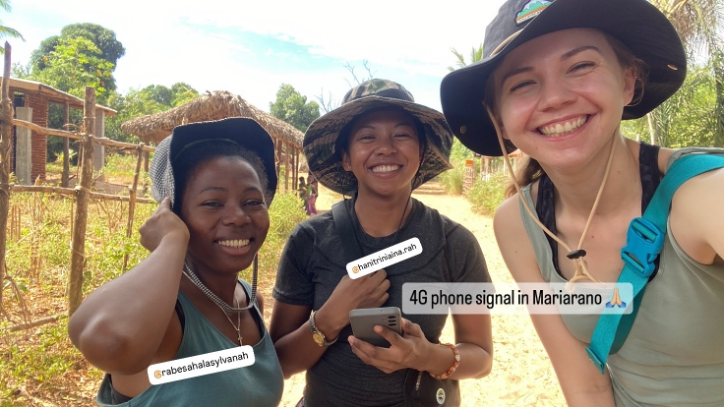First Month in the Field (Part 2): Thunderstorms in the Forest and Being Reunited with the Sifaka
Fieldwork 2024: Issue #3
Hi again! Time for update part 2 of the first month. I honestly didn’t realise I had so much to write about until I started typing and here we are on part 2 which is probably going to be just as long if not longer than part 1… sorry in advance!
In this update, I plan to focus on the first four weeks in Mariarano (my PhD field site) so you can get a bit of an idea of what we’ve been up to since getting here. I’m starting to work on this update only two weeks into the four as so much has happened already.
The ‘Mariarano road’
Let’s start with the journey to Mariarano. Mariarano is about a 50km, or a 3-hour drive north on a dirty track/road from Mahajanga (on a good day where you don’t get stuck in rush hour traffic getting out of Mahajanga). The ‘Mariarano road’ off the RN4 (National Road 4) takes you across the open savannah, over 2-3 river crossings and straight to the village of Mariarano. During the rainy wet season (November-March) the road becomes unusable in multiple parts due to the rivers filling, meaning the only way to access Mariarano is either via boat up the coast, or a 2-day (!) zebu cart ride around the river. Neither of these are viable options for me and the team, so early April was the earliest we could get to the site. Even though I knew cars had been getting to Mariarano from mid-March I also knew that cars and trucks had been getting stuck in the mud along the road, so I wasn’t sure what was going to happen when we set off on the morning of the 16th April.
Within 30 minutes of being on the road, we drove past a truck stuck in the mud and an attempt was made to tow it out…. This didn’t fill me with much confidence when we hit our first muddy patch. But after my heart was in my mouth for 5 minutes our driver (and his car) proved they could handle it, and all was fine. Luckily as there hadn’t been much rain recently the road itself wasn’t too bad, and we only hit 2-3 muddy parts and made it to Mariarano and the lust green forest (it looked very dead when we left last year, so this was great to see!) by around 1:30 pm. The rest of the day was spent unloading the two cars filled with our equipment and food, setting up camp and relaxing before dinner and an early night.
The main tasks when you first reach a field site before starting data collection are related. Luckily because this is now the 3rd time I have worked at the site for my PhD a lot of the admin was super easy to organise as the guides and camp staff we were going to hire knew we were coming (and waited at camp for us to arrive and welcome us!) and knew what needed to be set up and sorted. But usually, these tasks include hiring a cook, a camp guard/water porter, visiting the commune office so the mayor knows who you are and why you are here, and meeting with the president of the VOI (local community forest protection program) so they know what research you plan on doing, how long you plan to stay and who you plan on hiring from the VOI. We managed to get this all organised in the first 1 ½ days, meaning on day 3 we could get started with visiting the sifaka groups!
Seeing the grown-up gremlins (sifaka) for the first time!
When we left in October last year we had spent the past five months following 5 different groups of sifaka, with a total of 22 adults and 3 infants. We were all eager to see the groups as when we left them in October nearing the end of the dry season they weren’t looking in the best condition after having several months of no rain. The dry season (particularly June-October) is tough for the sifaka, the quality and quantity of their food have dropped drastically and mothers with infants have spent the past 5 months feeding not only themselves but also newborn infants. So, when we left the sifaka they were looking rough, which was hard to see, but as all 3 of the infants had made it through the toughest first few months of their lives (June-October) I was also kind of hopeful that they would make it through the wet season to this year.
As I write this at the start of May we have managed to get to and see 4 of the 5 groups* we followed last year, and I am happy to say that all the individuals survived the wet season and of these 4 groups 2 had infants who have also survived! (Seeing a sifaka you saw at only a few days old make it to nearly a year old and be an independent gremlin of its own is something special!). Although during the wet season, food resources are both more abundant and better quality there is still the threat of the weather. Due to the central highlands cutting through the middle of the island much of the bad weather (tropical storms and cyclones) that hits the east and north of the island doesn’t always make its way to the northwest, or if it doesn’t it isn’t usually as bad as it is in the east. However, the area of Mariarano can still be hit by bad tropical storms throughout the wet season, so we weren’t sure if all group members and infants would survive. But it appears all group members have survived (with the East Forest group gaining a new adult member), and at least 2 of the infants have survived (with the infant in the village group losing one eye between October and April!).
*it’s mid-May and we have still only managed to reach 4 of the 5 groups. But I am hopeful that we will get to the 5th group by the end of the month!
Sadly, though there is one group we haven’t managed to get to yet and see, the group that lives in the middle of the rice fields/paddies. During the wet season, all the rice paddies are filled with water, and currently, all the fields surrounding the group are filled with knee-to-waist-height levels of water so it’s not safe for us to get to them yet. But, in previous years we have managed to access this group by early June, so I am hoping to get to them in the next few weeks when the water levels are lower. I am particularly anxious to get to this group because when we left in October this group also had an infant, but around December/January time we heard from our guide that the infant didn’t appear to be with the group anymore and he thought it had potentially died. We won’t know 100% until we see the group, but I am hoping that the infant was just hiding on the day he went to see the group (fingers crossed!).
Rain in the dry forest!
I have always worked in the dry forest during the dry season, meaning I’ve never actually seen it rain in the forest or been in a wet/rain forest. So, you can imagine my excitement when it rained while we were out following one of the sifaka groups. Hearing the thunder in the distance and seeing the dark clouds slowly make their way over to us was an experience, especially as we had no idea how much it would rain or for how long. Turns out it only lasted for about 30-40 minutes and passed over us almost as quickly as it appeared. But for the 30 minutes while the rain was coming down I felt like I was living through a real-life soundscape of forest rainfall. The sounds of the water dropping on the leaves were magical, and it made me getting soaking wet completely worthwhile. The only problem was that we couldn’t collect any data while it rained as none of the data collection equipment was waterproof…
4G phone signal in Mariarano
The biggest shock of the past few weeks though has been the phone signal here at Mariarano. When we left in October the construction of a cell phone tower had just been completed and word on the street was that soon there would be a better phone signal in Mariarano (last year you would have to walk to the top of a hill and hope that you could get 1 or 2 bars to be able to make a phone call out), but it would only be 2G. But when we got here we found that across the village and in camp you could get 4G phone signal and could use the internet! It took my brain a good few days to get over this as for the previous four years I have worked here when you got to Mariarano you were pretty much cut off from the outside world completely.
Now, I can’t complain because being able to talk to people at home while in the field is incredible and being able to google something if you need to is a lifesaver, but it’s also surprisingly hard being able to have more contact with home. Also, having the stress of your emails being sent to your phone and not being able to hide from them for a few weeks, not a fan. But one thing is for sure, having actual phone signal makes the logistics of managing a field site and camp a lot easier, so for that I am grateful.
Anyway, I think I have rambled enough and honestly if you have made it this far, well done. I wasn’t lying when I told you this month was busy! But I hope you enjoyed this update and stay tuned for another update probably coming your way in early June time. If there is anything specific you want to hear about or have any comments or questions please let me know, I’d love to hear them.
See ya later,
Coral


